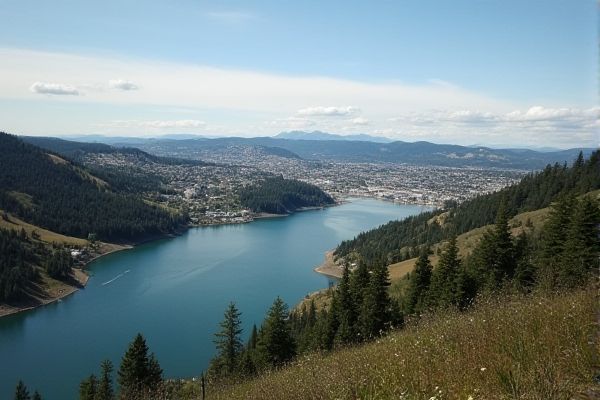
Internet and telecommunications options in Oregon: Major ISPs: Comcast, CenturyLink, Frontier. Fiber availability: Limited but expanding. Rural areas: Satellite or DSL options. Mobile carriers: Verizon, AT&T, T-Mobile. Average internet speed: Moderate. 5G coverage: Growing in urban areas. VoIP services: Widely available. Public Wi-Fi: Libraries, cafes, and parks. Bundled packages: TV, internet, phone deals. Regulatory oversight: Oregon Public Utility Commission.
Major ISPs: Comcast, CenturyLink, Frontier
In Oregon, major Internet Service Providers offer a range of options for fast and reliable internet connectivity. Comcast Xfinity is a prominent player, providing cable internet with impressive speeds that can reach up to 2,000 Mbps and ensuring widespread availability across 60% of the state. Another key provider, CenturyLink, delivers both fiber and DSL internet services, with speeds up to 940 Mbps, and has dedicated substantial resources to enhancing broadband services throughout Oregon. Frontier also contributes significantly to the state's internet landscape with high-speed fiber options reaching up to 7,000 Mbps. This expansion covers 95% of its service areas, thanks to considerable investments aimed at strengthening Oregon's network infrastructure. For a deeper dive into these providers and their offerings, visit CableTV's comprehensive guide.
Fiber availability: Limited but expanding
Fiber internet is available to about 62% of Oregon, with providers like Ziply, Centurylink, and Douglas Fast Net offering coverage. Speeds and availability vary across different regions, with the fastest plans reaching up to 10,000 Mbps in some areas. For more details on the coverage and plans available, you can visit the Fiber Internet and TV in Oregon webpage.
Rural areas: Satellite or DSL options
In rural Oregon, satellite internet through Viasat is a prominent option, offering download speeds up to 100-150 Mbps in some areas and at least 50 Mbps almost everywhere, with no data limits and reliable connectivity. For areas where satellite is not viable, DSL remains an alternative, though it often suffers from lower speeds and lower customer satisfaction compared to other technologies. To explore more about the available options and their compatibility with your needs, visit the Viasat Internet site, which provides detailed information on connectivity solutions throughout the region.
Mobile carriers: Verizon, AT&T, T-Mobile
In Oregon, Verizon and AT&T provide the most comprehensive 4G LTE coverage, with Verizon reaching 63.5% and AT&T covering 64.7% of the state. However, T-Mobile boasts the widest geographic 5G coverage, including regions such as Bend and along I-5 through Medford, despite having reduced 4G LTE coverage in certain rural areas.
Average internet speed: Moderate
In Oregon, while high-speed internet services are widely available, with 98.2% of residents having access to 10 Mbps or faster internet, the average speeds vary significantly by location. Many areas have access to speeds up to 5 Gbps, but average download speeds in various cities range from around 5 Mbps to over 70 Mbps, depending on the provider and location. For more detailed information on service availability and provider options, you can visit the Broadband Search website.
5G coverage: Growing in urban areas
In Oregon, 5G coverage is growing, particularly in urban areas, with T-Mobile offering the broadest geographic 5G coverage, including areas like Bend and along I-5 through Medford. Meanwhile, both AT&T and Verizon also provide 5G coverage, though it is more limited, especially in urban centers like Portland and Eugene. For more details on which cell provider is best around Oregon, you can visit KOIN.
VoIP services: Widely available
VoIP services are widely available in Oregon, offering businesses a cost-effective and feature-rich alternative to traditional phone systems, with providers like Oregon Phone Systems and sipVine providing robust features, high-quality voice calls, and flexible accessibility across the state.
Public Wi-Fi: Libraries, cafes, and parks
In Oregon, particularly in Eugene, free public Wi-Fi is available at various city facilities, including libraries, community centers, and public parks, as part of the city's strategy to provide widespread Wi-Fi access. Additionally, public libraries, cafes, and university campuses are popular spots for free Wi-Fi, making it easy for residents and visitors to stay connected. For more detailed information, you can visit the city's Public Wi-Fi page to explore the extensive network available to the community.
Bundled packages: TV, internet, phone deals
In Oregon, Mediacom offers bundled packages that include high-speed internet with speeds up to 1 Gig, Dish TV with numerous HD channels, and residential phone services with unlimited nationwide calling. These bundles provide a convenient and affordable way to manage all digital services on a single monthly bill. For more details on these offerings, visit their Mediacom Bundle Deals page.
Regulatory oversight: Oregon Public Utility Commission
The Oregon Public Utility Commission (PUC) oversees specific elements of telecommunications such as wholesale rates and interconnection agreements. However, it does not regulate Internet (broadband) service; this responsibility falls under the jurisdiction of the Federal Communications Commission at the federal level. For more detailed information about their regulatory purview, you can visit the Oregon Public Utility Commission website.
